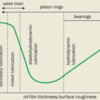Take three oils of the same 100C viscosity, say a 10w40 and a 15w40 and straight weight 40. The 10w40 will have more viscosity index improver polymers (VIIPs) than the 15w40 because the 15w40 starts with a somewhat thicker base oil. And the straight weight 40 will have no VIIPs. Now we know the VIIPs do not provide lubrication, but expand to maintain oil thickness at higher temperatures. What happens as we increase oil temperature above 100C?
I suspect that as oil temperature exceeds 100C (where all three of our "for example" oils are the same viscosity) that the 10w40 will remain thickest and the straight weight 40 will be the thinnest. Why? Because the VIPPs apparently are better at resisting thinning due to heat (after all they are designed for that purpose) than the oil.
After having said all that, it all seems pretty obvious, but I feel it might be worth some discussion. I recently switched from a 10w40 to a 15w40 that actually is rated about 0.5 cSt higher 100C viscosity than the 10w40. I expected my oil pressure to run a tad higher, but was suprised to find it actually ran a bit lower. The 15w40 (as compared to the 10w40) drops from its cold pressure sooner, stabilizes at the same 2000 rpm pressure (if not a tad lower), and hot runs 2 to 4 psi lower at idle. At first I thought maybe the SJ rated 15w40 I put in had deteriorated, but now I realize that, having less VIIPs, the 15w40 does not take high heat as well. So maybe minimizing VIIPS is not the best goal and I might be better off with the 10w40.
The next lesson I take from this is that my engine must be running oil pressure well above 100C, which may not be good. Anybody know what the oil temp should be? I don't have a temperature gauge, but at 100C this 15w40 should be showing slightly more pressure. The engine does have deposits in it and maybe an Auto-Rx treatment is in order.
Original Post


